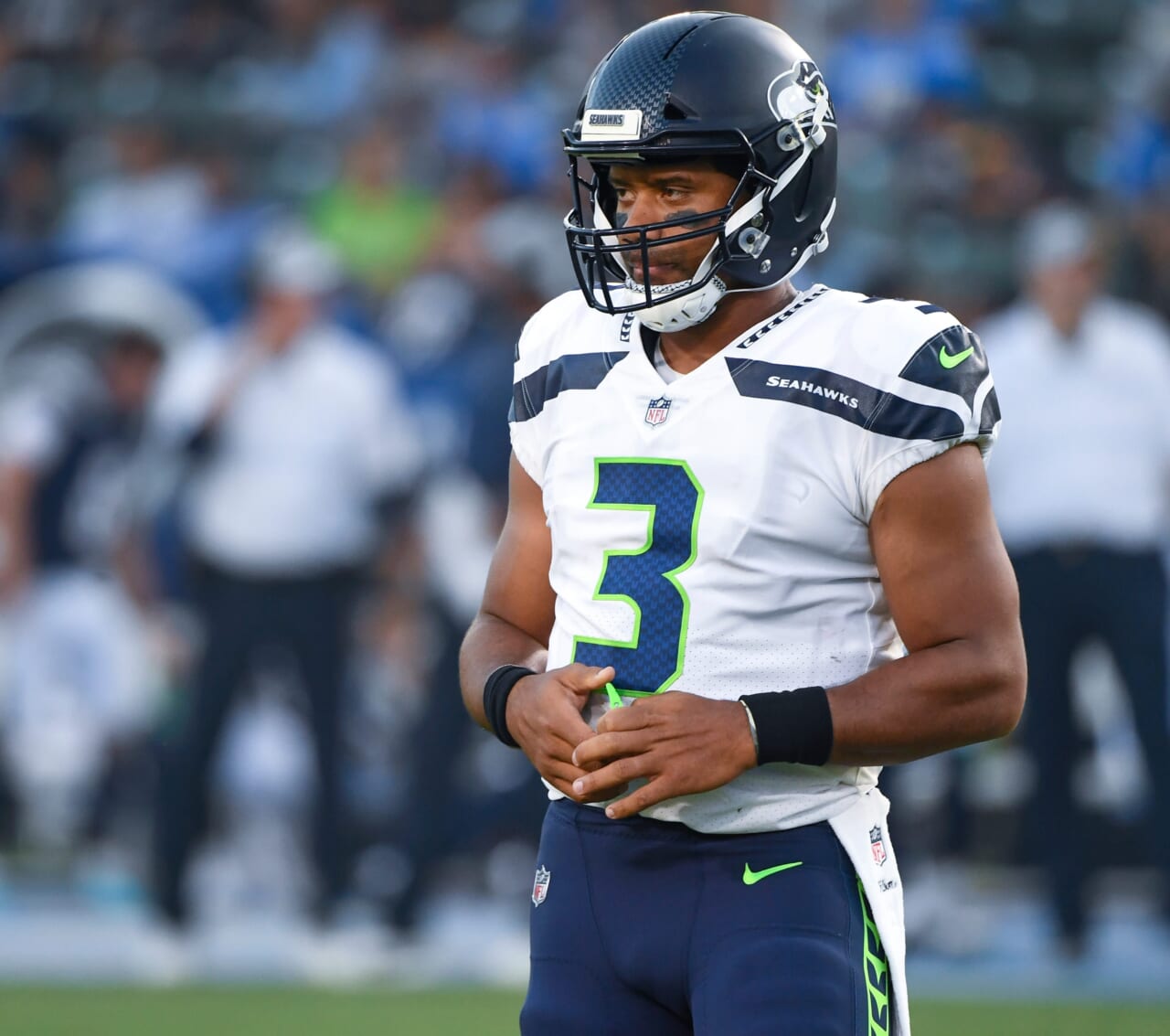The idea of a New York Giants blockbuster trade for Seahawks star quarterback Russell Wilson might be far-fetched and full of speculation, but it isn’t impossible.
Seattle has been delivered an ultimatum by Wilson – they have until April 15th to unload a new deal for the six-time Pro Bowler. What comes next could be what gives the Giants an opening into a potential trade scenario.
Working through the longshot scenario of Russ finding his way to New York:
Unlike the Josh Rosen trade rumors ahead of the draft, the Wilson option would undoubtedly be an expensive one. The Giants have approximately $11.78 million in remaining cap space, far less than Wilson is expected to earn in a new deal, but there are ways to open up wiggle room that could make a trade possible.
In comparison, Green Bay signal caller, Aaron Rodgers, is earning $26.5 million for the 2019 season, which is right around what Wilson would likely earn. Similar to Rodgers, the Giants could theoretically increase his cap-hit in the later years. Rodgers will bring in $33.5 million in 2021 and $37 million in 2022.
If the Seahawks balk on a new deal, possibly due to the inevitable drop-off of aging quarterbacks, especially one who relies on mobility like Wilson, a small window of opportunity opens. Giants GM Dave Gettleman would have to come to terms with two realities – Eli Manning must either be traded or cut, opening up $11 million in cap space.
Such an end to the Manning era would be an abrupt way to close the book on 15 years of service, but this isn’t Geno Smith. Fans will thank Eli, but should quickly adjust to the new normal.
With the trade of Odell Beckham Jr. locking up $16 million in dead cap money, it leaves the Giants a bit hamstrung, but 2020 opens the flood gates for spending.
How does the 2019 NFL Draft factor into this deal?
The No. 6 overall pick in the draft costs $4.6 million and the 17th pick $2.3 million, equaling about $7 million in allotted cap-space. A deal including Wilson would likely cost the Giants both picks, clearing that $7 million to go toward the veteran QB’s new deal in 2019.
One downside? This trade prevents the Giants from using high picks to address its holes on the defensive line, at linebacker, and in the secondary. But, trading for a top-5 quarterback could be worth it – there are ways to compensate for lack of star-power on defense.
Additionally, finding Saquon Barkley a top-tier compliment to lessen his workload and savor his health is essential. Wayne Gallman is talented but can’t be trusted to compensate for Barkley not being on the field. This is just another assumed priority that must be added to the long list of unresolved holes on the team.
What is Eli Manning’s role in this speculative scenario?
Manning has a no-trade clause and counts $11 million in dead money (Spotrac), which leaves him with the final word. He’s either included in the deal and is sent to Seattle, or he can be cut. Either way, the Giants are out the $5 million roster bonus Manning received in March, but the move still opens up a vital $11 million in available cap space to allocate towards Wilson.
In total, getting rid of Manning and trading the first two picks would clear up $17 million in cap. This still isn’t enough to reach Russell’s worth on a per year deal. Again, Rodgers is earning $26.5 million in 2019, making that the benchmark for passers of such quality.
What else can the New York Giants open up cap?
The obvious move is for the Giants to restructure newly acquired guard Kevin Zeitler’s contract for savings against this year’s cap. By converting $6.5 million of his 2019 salary into a signing bonus, they can spread the money over the remainder of his deal. It would open up about $4.333 million in space, according to Forbes.com.
With these moves, the Giants could have roughly $26 million in total cap space to work with in a potential deal for Wilson, which is more than enough if they backload his salary to later years in the deal. Though some cash would have to be retained to sign the remainder of the draft class — about $6 million spread between 10 picks if the Giants chose to hold them all.
Again: While this remains purely speculative, there are ways to manipulate the salary cap to make interesting scenarios like this a possibility.
The consequences:
The downside to this deal is losing the draft picks. The two first-rounders lost limit the Giants’ ability to allocate resources towards the defense. However, a host of mid-round picks (10 remaining) can be used to secure depth and potential upgrades on both sides of the ball. Additionally, 2020 would offer around $80 million — minus whatever cap number Wilson commands — in available cash for the Giants to be aggressive on the free agent market.
This theory negates the idea of building around a young, inexpensive quarterback or keeping Manning for any longer and jumping right into a position of contention. With one year of chemistry building and draft pick experience, building around Wilson seems to emerge as a realistic option if the front-office can accept letting Manning go.
